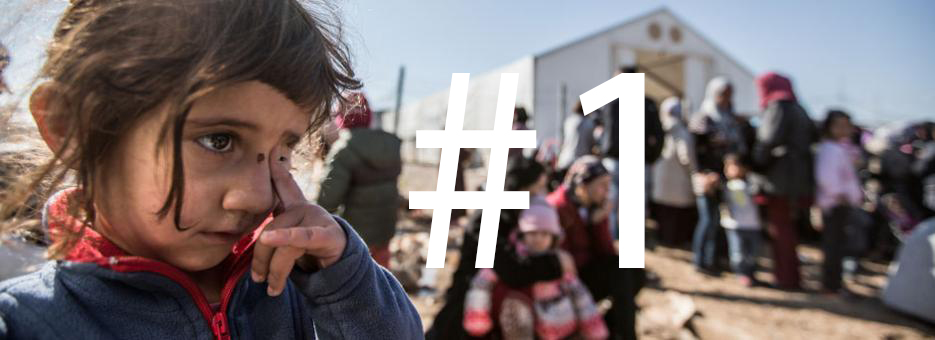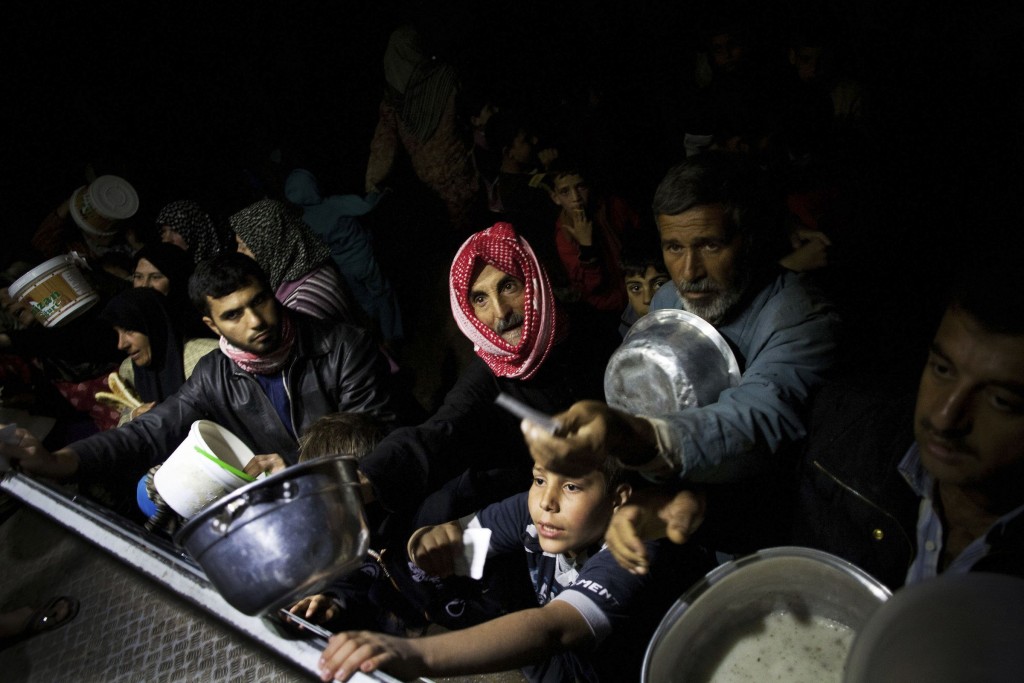The conflict in Syria is looking more and more like a proxy war between the US and Russia. And this week Germany came to the rescue opening its boarders to fleeing Syrian refugees desperate to find a safe place to rest.
We offered a story on the dangerous journey people are taking to get to Europe earlier this summer. That piece was on people fleeing from Libya. Since then the crisis has escalated. Now the refugees are coming from Iraq, Afghanistan and Syria. Smugglers are in high demand, despite the well know risk of being held hostage, the high incidents of rape and torture. People are frantic to get out of Syria where the war between the Assad Regime, The Islamic State and the Kurds rages on.
Part of this tragedy is the number of children impacted. An entire generation of Syrian children exposed to a life of violence and fear unlike anything most of us know.
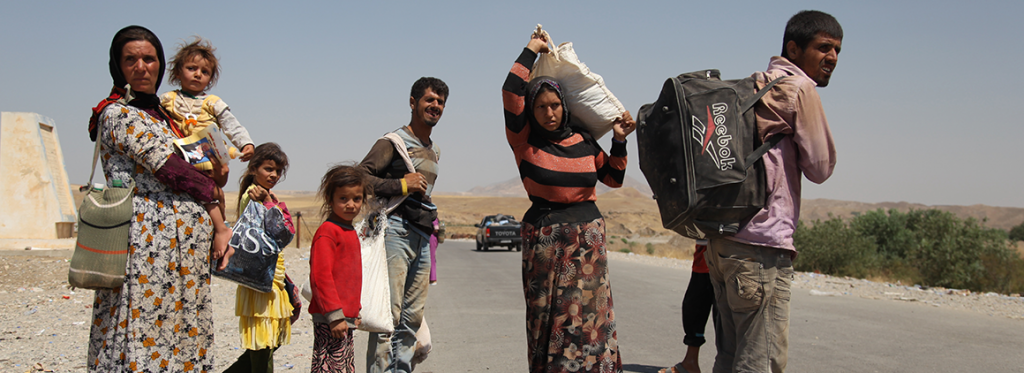
According to UNICEF: “7.5 million Syrian children, inside and outside the country, are in need of humanitarian aid, and millions have borne witness to unrelenting violence from the brutal conflict that began more than four years ago. 2.6 million children are no longer in school and 2 million are living as refugees in neighboring countries or on the run in search of safety, helping to fuel a global migrant crisis. Syria is now the world’s biggest producer of both internally displaced people and refugees.”
Rather than giving you one piece this week, I thought we’d try to do a wrap up on the issues and give you some context for why people are fleeing Syria in such masses, risking everything for a better opportunity. I’ll also try to provide you with some background and make the case that this is much more complex than just the Assad regime, Free Syrian Army and ISIS. (Each link is to a great story with more info on the topic.)
A few things to keep in mind:
1. Russia is active in Syria; helping Assad. This adds a new layer to the already complex situation. The US has tried to downplay any involvement in Syria, you may remember Obama’s “red line” on chemical weapons talk, which then that backfiring when we learned Asad had most likely used chemical weapons on his own citizens, and we still didn’t “do anything.” In Jan of 2015 we learned the CIA had been doing something, but it probably wasn’t working. “Assad’s regime has also killed more civilians than its terrorist opponents Isis in a civil war which has seen 250,000 people die, reported the Daily Telegraph.” Keep in mind that while this civil war in Syria is between the Kurds and the Assad regime and the Islamic State. Top US military brass just listed Russia — not the Islamic State — as our number one threat. SEE our second pick of the week for more on Russia...So it’s starting to feel more and more like developments on the ground in Syria are being manipulated by US-Russia foreign policy conflicts in a kind of proxy war. On Sept 5, 2015 Vladimir Putin, told Russian State TV: “We are already giving Syria quite serious help with equipment and training soldiers, with our weapons.” Putin’s explaining Russia’s involvement as an effort to fight terrorism and destroy the ISIL/The Islamic State/ In a piece in Foreign Affairs from 2013, we learn a lot more about Putin’s motivations in Syria and his fears of radical Sunni Islamic groups. From Foreign Affairs:
Why has Putin offered such steadfast support to Assad? On the surface, Moscow seems to profit from exporting arms to Syria, and it depends on the regime’s good will to maintain Russian access to a naval facility at the Mediterranean port of Tartus. But these are marginal and symbolic interests. Putin is really motivated to support the Assad regime by his fear of state collapse — a fear he confronted most directly during the secession of Russia’s North Caucasus republic of Chechnya, which he brutally suppressed in a bloody civil war and counterinsurgency operation fought between 1999 and 2009.
For Putin, Syria is all too reminiscent of Chechnya. Both conflicts pitted the state against disparate and leaderless opposition forces, which over time came to include extremist Sunni Islamist groups. In Putin’s view — one that he stresses repeatedly in meetings with his U.S. and European counterparts — Syria is the latest battleground in a global, multi-decade struggle between secular states and Sunni Islamism, which first began in Afghanistan with the Taliban, then moved to Chechnya, and has torn a number of Arab countries apart. Ever since he took office (first as prime minister in 1999 and then as president in 2000) and was confronted by the Chechen war, Putin has expressed his fear of Sunni Islamist extremism and of the risks that “jihadist” groups pose to Russia, with its large, indigenous, Sunni Muslim population, concentrated in the North Caucasus, the Volga region, and in major cities such as Moscow. A desire to contain extremism is a major reason why Putin offered help to the United States in battling the Taliban in Afghanistan after 9/11. It is also why Russia maintains close relations with Shia Iran, which acts as a counterweight to Sunni powers.
One could make the argument that Assad used fears, similar to Putin’s fear of Sunni extremists, to turn a local conflict, which started as a rebellion in the Arab Spring against his brutal rule into a world crisis. Assad, mobilized the extremists by defending the religious minorities, inciting a reaction and defining the conflict on religious grounds rather than political or personal — people just not liking his dictatorship.
Assad deliberately targeted Syria’s Sunni Muslim majority, civilian and rebel alike, for slaughter. His goal was to polarize the conflict on religious lines, to turn what began as a broad-based uprising against a dictator into a sectarian war, with religious minorities on his side. He knew this would attract extremists to the rebel side, which would make the world afraid of seeing Assad lose.
The politics are complex, but the human condition is usually quiet simple. People don’t need much and most people want to stay in their home countries. So why have more than 4 million Syrians fled? The option to stay home is worse than the alternative. More than 250,000 have been killed in the Syrian civil war in the past 4 years, and more than 2 million have been pushed out of their homes, that’s roughly half of the country’s population.
Vox offered us a visual rendering of this crisis and a brief overview of what’s happened:
“The chilling photograph of toddler Aylan Kurdi’s body washed up on the Turkish shores, after a failed attempt to flee to Europe, forced people to start thinking about what it meant that 4 million Syrians had become refugees — and what needed to be done to help them.”
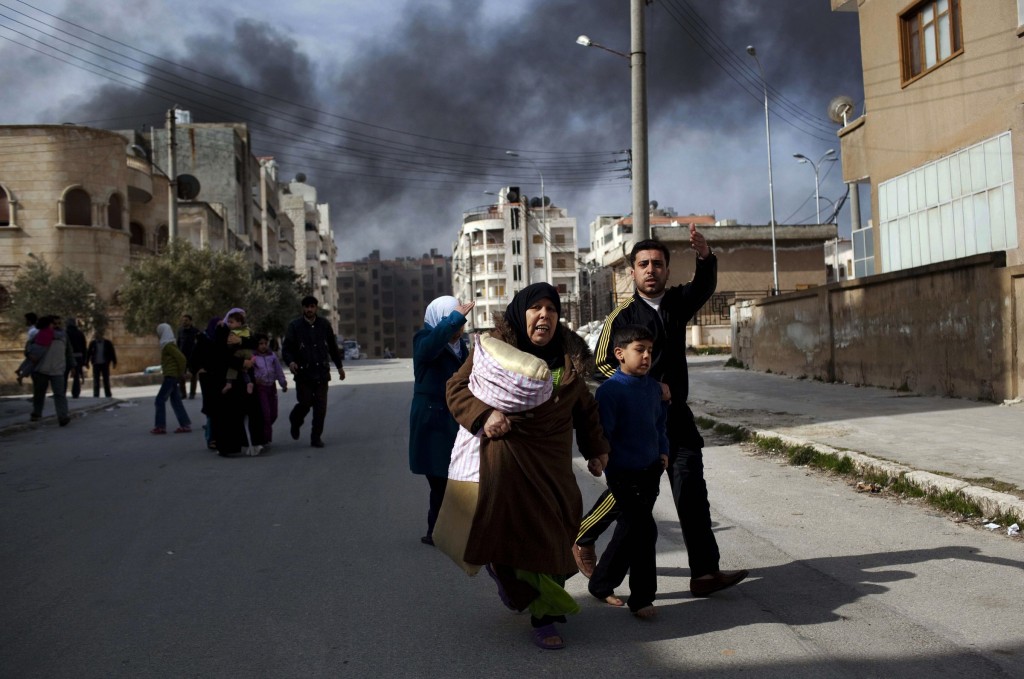
Part of the reason Syria’s war has been so devastating is the intense fighting inside densely populated cities. The above photo, part of a Pulitzer Prize–winning collection from 2012, shows what that looks like in practice — a family in the city of Idlib fleeing from the violence overtaking their city. (AP Photo/Rodrigo Abd)
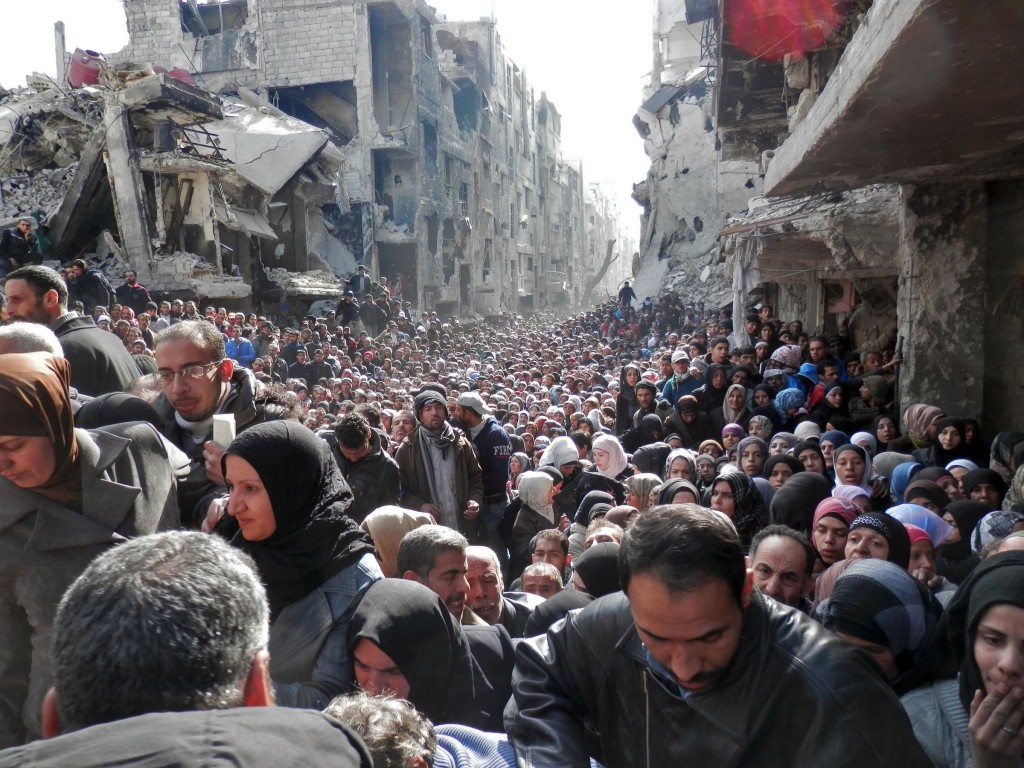
This is the Yarmouk refugee camp, which houses Palestinians, in Damascus. It’s been described as a “living hell” and “the worst place on Earth,” as a result of the utterly miserable living conditions. This 2014 photo, which shows masses of people waiting for food and aid amidst bombed-out buildings, is a perfect encapsulation of how bad things have gotten in Syria. (United Nation Relief and Works Agency/Getty Images)
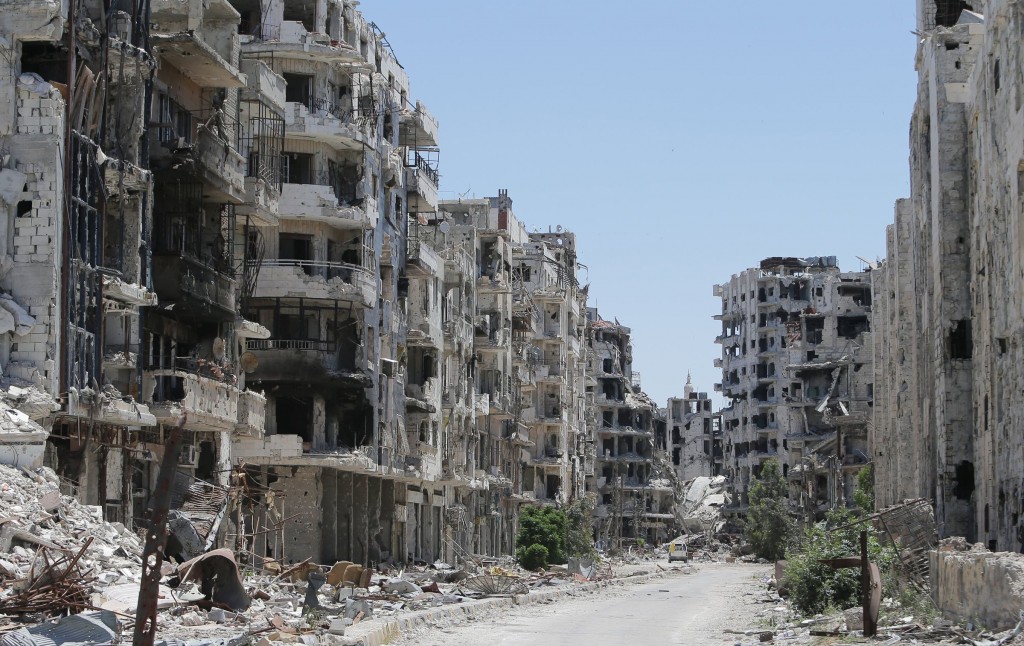
These shattered buildings are in the Khaldiyeh neighborhood in Homs, in 2014. It’s a city that was described as the “capital of the revolution” when anti-government protests began in 2011 for the intensity of the protests there. The complete destruction there is a testament to how thoroughly Bashar al-Assad’s strategy to deal with the protests — attack them mercilessly, and turn the peaceful revolution into a civil war — has succeeded. (Joseph Eid/AFP/Getty Images)
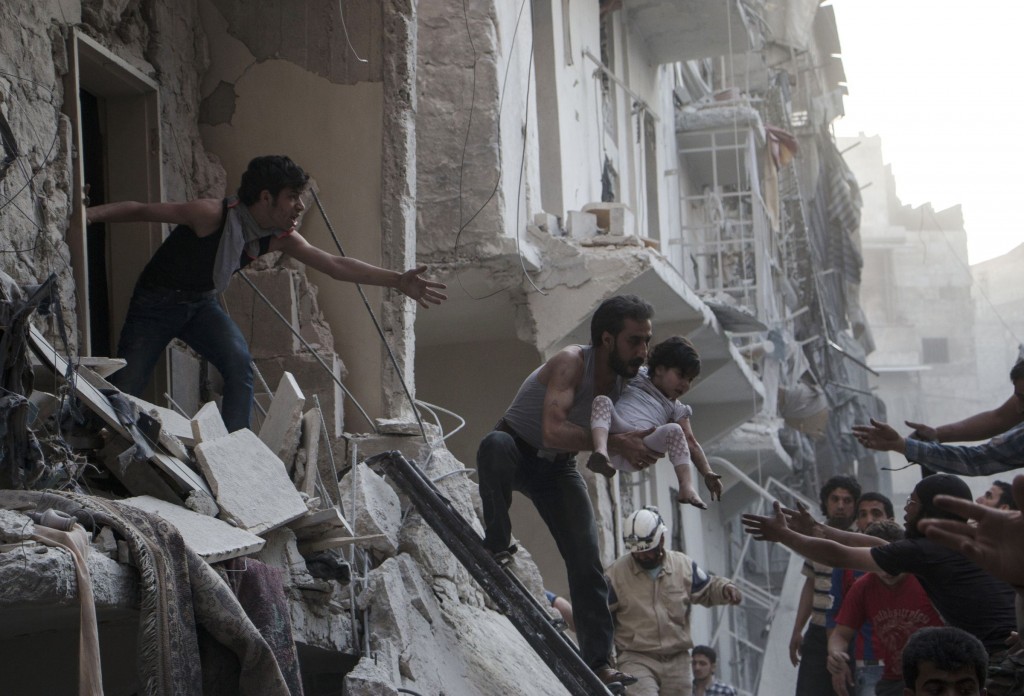
The Assad regime has deliberately and extensively targeted Syrian civilians during the war. What you see above is the aftermath of a “barrel bomb” attack in Aleppo, in May 2015. Barrel bombs are containers filled with explosives and sometimes metal, indiscriminately dropped from helicopters. “Assad’s indiscriminate use of barrel bombs deep in opposition-held territory means that for many there is no safe place to hide,” Kenneth Roth, the executive director of Human Rights Watch, writes in the New York Times. (Karam al-Masri/AFP/Getty Images)
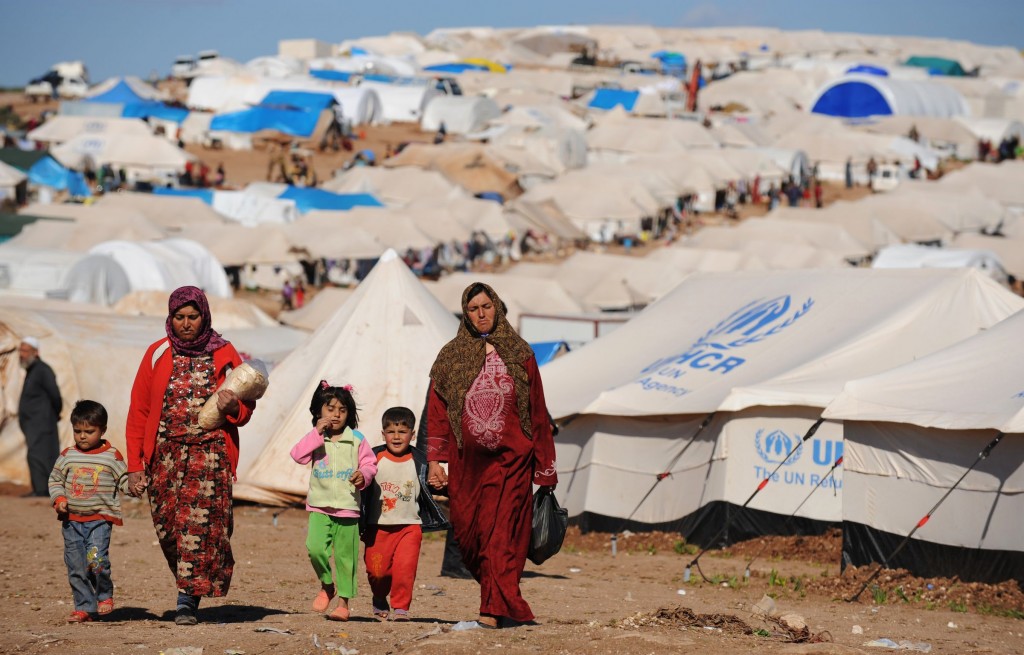
As a result of this horrific violence, about 7.6 million Syrians have been internally displaced — stuck in Syria, but forced out of their homes. These people often live in crowded and underfunded camps, like the Atme camp on the Turkish border, pictured above in 2013. (Bulent Kilic/AFP/Getty Images)
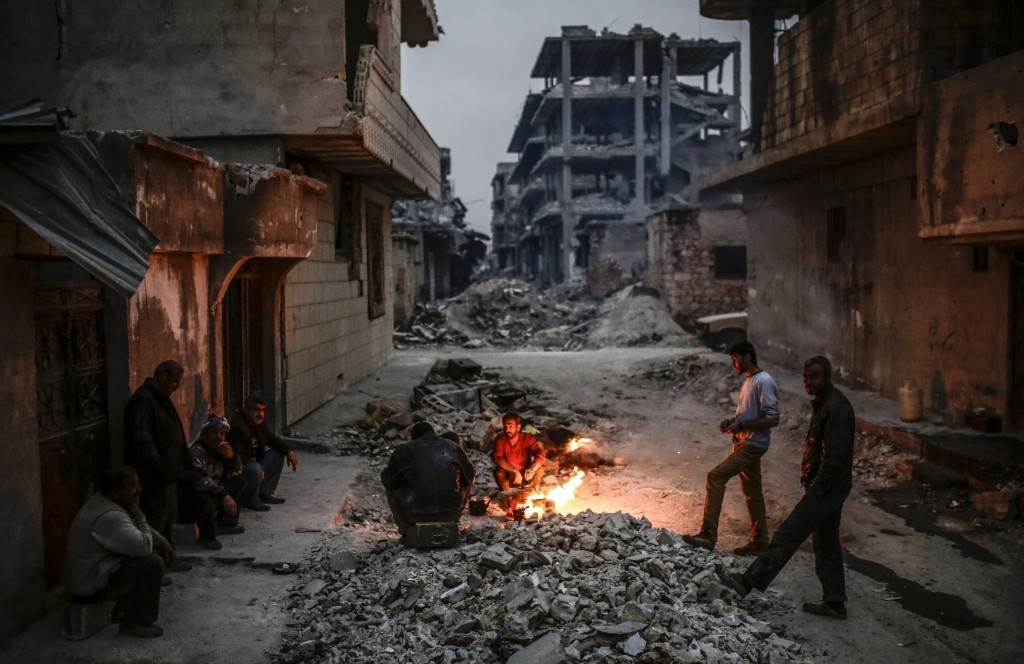
Since ISIS entered the war in force in 2013, the group has targeted civilians and destroyed whole neighborhoods as well. The above scene shows Kurdish Syrians in Kobane, Syria — a place besieged by ISIS for months. While ISIS was driven out of Kobane earlier this year, the cost to the city and its residents was absolutely devastating. (Yasin Akgul/AFP/Getty Images)

Of the roughly 4 million Syrians made international refugees by the conflict, the overwhelming bulk are living in neighboring countries, particularly Lebanon and Turkey. They’re often stuck in hastily constructed and poorly funded refugee camps — like these children in an unofficial refugee camp in Jbaa, Lebanon, in late 2014. (Anwar Amro/AFP/Getty Images)
If you’ve read this far you may care about the children impacted in this crisis. We encourage anyone hoping to make a difference to consider a donation to UNICEF where 90 percent of your donation goes to helping these refugee children. http://www.unicefusa.org/stories/child-refugee-crisis-how-you-can-help/27186


